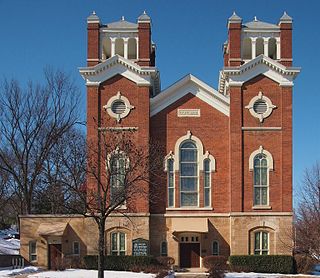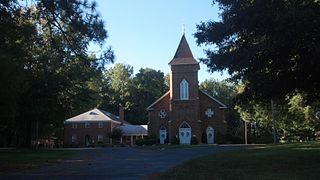Presbyterianpolity is a method of church governance typified by the rule of assemblies of presbyters, or elders. Each local church is governed by a body of elected elders usually called the session or consistory, though other terms, such as church board, may apply. Groups of local churches are governed by a higher assembly of elders known as the presbytery or classis; presbyteries can be grouped into a synod, and presbyteries and synods nationwide often join together in a general assembly. Responsibility for conduct of church services is reserved to an ordained minister or pastor known as a teaching elder, or a minister of the word and sacrament.

Valdese is a town in Burke County, North Carolina, United States. The population was 4,490 at the 2010 census. It is part of the Hickory-Lenoir-Morganton Metropolitan Statistical Area. One of the largest Waldensian congregations in the United States was founded in the town in the late nineteenth century, now known as the Waldensian Presbyterian Church. The town was settled by immigrants from the Cottian Alps in the Piedmont region of Italy.

The Waldensians, Vallenses, Valdesi or Vaudois) are adherents of a proto-Protestant church tradition that began as an ascetic movement within Western Christianity before the Reformation.

Monett is the most-populous city in the Barry and Lawrence counties in the U.S. state of Missouri. The city is located in the Ozarks, just south of Interstate 44 between Joplin and Springfield. According to the 2010 census, the population of the town was estimated to be 8,873 individuals. The population was estimated to be 9,124 by the City of Monett on July 1, 2019.

Westminster Hall and Burying Ground is a graveyard and former church located at 519 West Fayette Street in Baltimore, Maryland, United States. It occupies the southeast corner of West Fayette and North Greene Street on the west side of downtown Baltimore.

The Cold Spring Presbyterian Church (www.coldspringchurch.com) is home to a congregation of worship and mission of the Presbyterian Church (U.S.A.) and West Jersey Presbytery that began in 1714, and continues to believe that everyone deserves to experience God's love in relevant and authentic ways. The thriving faith community began a community-focused transformational initiative in 2016. Cold Spring Presbyterian Church delivers spiritual resources and experiences that are centered in God’s love and proclaim the abundant life through Jesus Christ to make greater Cape May a better place through worship, activities, events, and other ministries.

The Old Scotch Church, also known as the Tualatin Plains Presbyterian Church, is a church and national historic site located in an unincorporated part of Washington County, Oregon, near Hillsboro, Oregon, United States. The church dates to 1873 while the church structure with an eight-sided steeple dates to 1878. A cemetery on the church grounds holds the graves of church members and local pioneer settlers of the Tualatin Plains, including Joseph Meek.

First Presbyterian Church, known also as First United Presbyterian Church, is a church located at 602 Vermillion Street in downtown Hastings, Minnesota, United States, listed on the National Register of Historic Places. It is significant for its Romanesque architecture. The building is characterized by its massive quality, its thick walls, round arches, large towers, and decorative arcading.

First Presbyterian Church and Manse is a historic Presbyterian church located at West Madison Street and Park Avenue in the Mount Vernon-Belvedere neighborhood of Baltimore, Maryland, United States. The church is a rectangular brick building with a central tower flanked by protruding octagonal turrets at each corner. At the north end of the church is a two-story building appearing to be a transept and sharing a common roof with the church, but is separated from the auditorium by a bearing wall. The manse is a three-story stone-faced building. The church was begun about 1854 by Nathan G. Starkweather and finished by his assistant Edmund G. Lind around 1873. It is a notable example of Gothic Revival architecture and a landmark in the City of Baltimore.

Buffalo Presbyterian Church is a historic Presbyterian Church located in Pamplin, Prince Edward County, Virginia. Built about 1804, it is a simple frame weather-boarded structure with a gable roof covered with standing seam metal. Early in the 20th century the front of the church was reoriented to the east and, in 1931, an addition was made, consisting of an entrance vestibule flanked on either side by a small classroom. Also on the property is the contributing church cemetery, with a number of stone markers, the earliest of which is dated 1832. The congregation of Buffalo was formed in 1739 and is the earliest extant Presbyterian congregation in Southside Virginia.

Old Brick Church, which is also known as Ebenezer Associate Reformed Presbyterian (ARP) Church or First Associate Reformed Presbyterian Church is a church built in 1788 about 4 mi (6 km) north of Jenkinsville on SC 213 in Fairfield County, South Carolina. It was named to the National Register of Historic Places on August 19, 1971. It is one of the few 18th-century churches surviving in the South Carolina midlands.

The First Presbyterian Church is a historic church building in Columbia, South Carolina. Constructed in 1854, it was added to the National Register of Historic Places on January 25, 1971.

Waldensian Presbyterian Church is a historic Waldensian church at 104 East Main Street in Valdese, Burke County, North Carolina.

Thyatira Presbyterian Church, Cemetery, and Manse is a historic church at 220 White Road off NC 150 in Mill Bridge in Rowan County, North Carolina, ten miles west of the town of Salisbury. Presbyterians have been worshiping at this site since at least 1753.

Black River Presbyterian and Ivanhoe Baptist Churches are historic Presbyterian and Baptist churches located on SR 1102 east of SR 1100 in Ivanhoe, Sampson County, North Carolina. Associated with each church is a cemetery. Among the founders of the Black River Presbyterian congregation were immigrants, from Isle of Arran, Patrick Murphy (1720-1785) and Elizabeth Kelso (1724-1798), who are buried in the Black River Presbyterian Church Cemetery. The original wooden markers for these graves, now in Sampson County History Museum, were replaced by marble stones. The current Black River Presbyterian Church structure was built in 1859, and is a one-story, temple form, Greek Revival style frame church with an impressive pillared portico. The Ivanhoe Baptist Church was built in 1893 or 1895, and is a vernacular Gothic Revival style frame church. The Presbyterian congregation was founded in 1740 by Scots from the Island of Arran and from mainland Scotland.

New Providence Presbyterian Church is a historic church in Surgoinsville, Tennessee, United States, affiliated with Presbyterian Church (USA).

The South Henderson Church is a historic Presbyterian church located in rural Henderson County, Illinois, east of the village of Gladstone. The church was built in 1854; it was the second church building used by the local Associate Reformed Presbyterian congregation, which formed in 1835 and built its first church two years later. The vernacular building has a wood frame plan and limestone walls and used local materials in its construction, which cost $3,855.55. Reverend Robert Ross led the congregation when it built the 1854 church; Ross was one of the founders of Monmouth College and served on its first Board of Trustees.

David W. Courdin House, also known as the Old Courdin House, is a historic home and national historic district located near Monett, Barry County, Missouri. It was built in 1876, and is a grouping of house and farm buildings associated with the Waldensian community. They include the one-story, gable roofed stone dwelling, a usable cistern, well and vegetable cellar, the ruins of the original dairy barn and smokehouse.

The Old Scots Burying Ground is a historic cemetery located on Gordon's Corner Road in the Wickatunk section of Marlboro Township, in Monmouth County, New Jersey. It was added to the National Register of Historic Places on August 15, 2001, for its significance in history and religion. The Old Scots Burying Ground is about an acre in size, about 195 feet above sea level and dates back to 1685. The total number of burials at the cemetery is not precisely known, suggested by Symms, "There are a large number of graves in Old Scots yard without any inscribed stones". Some reports place the number as at least 100 known graves with most headstones of brown sandstone. However, more recent research using ground penetrating radar reported by the Old Tennent Church in 2001 has put the number of confirmed sites at about 122 graves with a possible 140 more unmarked; placing the number at about 262 total graves in the cemetery. In 1945, in an attempt to clean out the site of vegetation and over-growth, a bulldozer was used on the property and as a result some headstones were dislodged and broken stones removed. The defining structure in the cemetery is a tall monument to Rev. John Boyd, created by the J&R Lamb Company. Built to commemorate the first recorded Presbyterian ordination of Rev. John Boyd. The monument is currently owned by the Synod of the Northeast who holds the property deed but it is maintained by the Old Tennent Church. The last identified burial was in 1977.

The Old Stone Church is a historic sandstone church located in Kingwood Township in Hunterdon County, New Jersey. It was built in 1837 and is now owned by the First Unitarian Universalist Fellowship of Hunterdon County. The church, described using its historic name, Old Stone Presbyterian Church in Kingwood, was added to the National Register of Historic Places on January 25, 2018 for its significance in architecture. The earlier church located here was a smaller stone building built in 1755, called the Old Stone Meetinghouse. The stones from this church were probably used to build the current one. The Kingwood congregation was established in 1728 and grew during the First Great Awakening, with Gilbert Tennent and George Whitefield preaching here in 1739.






















